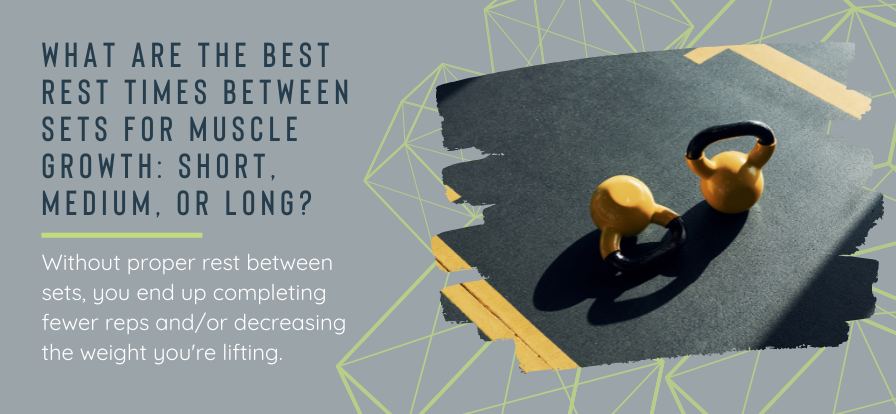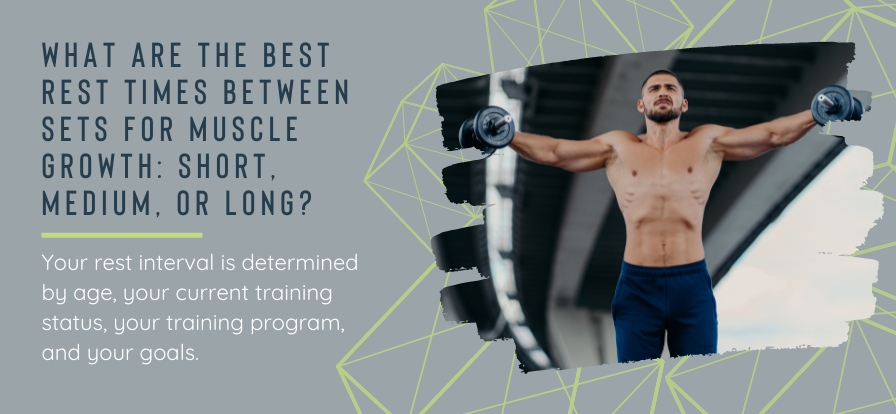What Are the Best Rest Times Between Sets for Muscle Growth: Short, Medium, or Long?
If your strength training goal is muscle growth, your rest time between sets could be one of the most critical factors of your exercise program. Do you need a short rest period between sets? Or do you need to take a break for several minutes before hitting the weights again?
The short answer is: it depends on your goals!
This blog post will look at what research says about the optimal amount of rest between sets to enhance your muscle gains. Read on for more.
What Are Your Strength Training Goals?
When it comes to strength training, some want to build muscle and bulk up, while others want to lose fat and get leaner. In addition, some exercisers might care primarily about increasing strength and power, and others want to increase endurance.
In any scenario, the following weight lifting variables will affect your results:
Reps: The number of repetitions of an exercise, usually done in succession without stopping
Sets: A group of repetitions (typically 6-15 reps in one set)
Rest time: The amount of time you take to rest between sets
Load or intensity: How much weight you're lifting; often measured as a percentage of 1 RM or maximum repetition (the most weight you can lift for one rep)
Frequency: How often you're strength training a particular body part per week
As you can see, altering any of these factors will affect the others and, ultimately, your results. To build muscle size, you want to increase volume and gradually overload your muscles.
In this post, we're looking specifically at rest periods but be sure to read Progressive overload training principle: Why it's so important for results! for a great overview of keys to progressive training.
Why Is Rest Important in Strength Training?
Rest and recovery are just as vital as work for anyone looking to get stronger. That's because when you lift weights, your muscles experience micro damage. The repair process includes muscle protein synthesis, which leads muscles to grow larger and stronger.
The key player is your myofibrils. Myofibrils are the contractile units within muscle cells that are responsible for generating force. When you strength train, you cause myofibrils to increase in size and number. Research shows that increasing the muscle cross-sectional area (CSA), which is accomplished when you pursue muscle hypertrophy, is crucial for increasing force and power for athletes.
So recovery days are vital, but rest within the workout itself–aka “interset rest”–is also valuable. That's because as you fatigue, your form starts to suffer, and you're more likely to tire or get injured. As you get tired, your nervous system can't fire the muscles as effectively, which leads to a decrease in strength.
Finally, without proper rest between sets, you end up completing fewer reps and/or decreasing the weight you're lifting, affecting your total training volume.
So, how much rest time should you take between sets? Let's look at the research!
Best Rest Time for Building Muscle
Your rest interval is determined by age, your current training status (beginner to advanced), your training program, and your goals.
The American College of Sports Medicine (ACSM) recommends higher volume, multi-set programs for maximizing hypertrophy (muscle growth) for beginner to intermediate exercisers. This includes 1-2 minutes of rest between sets and emphasis on the 6-12 repetition max (RM) range.
For more advanced exercisers who emphasize heavier weights in the 1-6 RM range, ACSM recommends a 3-5 minute rest between sets.
Let's also look at findings from a review in the Journal of Sports Medicine. In this study, researchers reviewed 35 studies and found that:
In acute responses, when training with loads between 50% and 90% of one repetition max, 3-5 minutes of rest between sets allowed for greater repetitions over multiple sets.
In chronic adaptations, 3-5 minutes of rest between sets produced greater increases in absolute strength because of higher intensities and volumes of training.
Higher levels of muscular power were demonstrated over multiple sets with 3-5 minutes versus 1 minute of rest between sets.
The benefits of these longer rest intervals are related to power and strength goals. The same review also says, "When the training goal is muscular hypertrophy, the combination of moderate-intensity sets with short rest intervals of 30-60 seconds might be most effective due to greater acute levels of growth hormone during such workouts."
Another study investigated the effects of short (1-minute) and long (3-minute) rest periods with 21 resistance-trained men. This study found that after eight weeks of total body workouts three times a week, the group with 3-minute rest periods saw significantly greater gains in maximal strength and muscle thickness. The authors concluded longer rest periods are ideal for improving muscle strength and hypertrophy in young resistance-trained men.
Another element to consider is whether the type of exercise you're doing affects the amount of rest your body needs. Another study measured the effects of rest periods on single versus multi-joint exercises. Researchers found that a rest interval of 2 minutes between sets was sufficient for the single-joint exercises, and 3-5 minutes was ideal for a multi-joint exercise. These rest timeframes allowed subjects to complete significantly higher total repetitions.
So, you may need to adjust your workout and allow for extended rest periods for compound vs. isolation exercises.
The Bottom Line on Rest Between Sets
The ideal amount of rest should allow you to complete the highest total training volume. Conversely, with inadequate rest, you may "burn out" before completing the ideal number of reps and at an appropriate weight for your level.
If you're a novice exerciser, haven't been training consistently over the last 6-12 months or are working out with a linear focus on muscle growth, you should be able to meet your goals for strength gain with 1-2 minutes of rest between sets for most exercises. However, if you are more advanced and want to prioritize strength and power over growth, 3-5 minutes of rest between sets is ideal when working in the low reps range (1-6), especially for compound exercises such as squats, deadlifts, bench press, etc.
Ultimately, you want to be able to complete the prescribed number of reps and sets at the designated weight for your strength training program (with good form, of course). If you cannot do so, consider increasing your rest time between sets.
Resources
https://www.powerliftusa.com/filesimages/Sports%20Science%20Board/Articles/The%20Importance%20of%20Muscular%20Strength/The%20importance%20of%20muscular%20strength_Training%20considerations%20(002).pdf
https://pubmed.ncbi.nlm.nih.gov/19204579/
https://pubmed.ncbi.nlm.nih.gov/19691365/
https://pubmed.ncbi.nlm.nih.gov/26605807/
https://journals.lww.com/nsca-jscr/Fulltext/2016/03000/Effect_of_Different_Interset_Rest_Intervals_on.14.aspx




